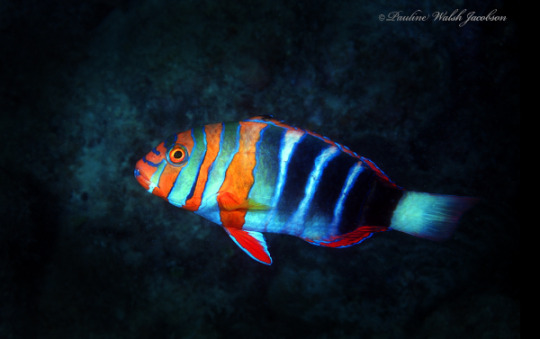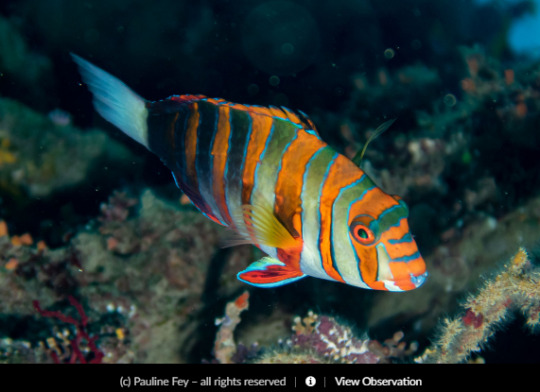#Wrasse
Explore tagged Tumblr posts
Text

You get a Bird Wrasse (female)
Gomphosus varius
If you're ever feeling embarrassed about feelings, remember that i, girl-detector, have at least two times recorded where i was a sopping wet creature about it
If i said [REDACTED] right away, things would be very different now, to a point where someone else may have started girl-detector instead of me
Girls are pretty, keep that in mind 👍

4K notes
·
View notes
Text

Tool Use by New World Halichoeres Wrasses
Juliette Tariel-Adam, Jaqueline G. Toledo, C. E. O’Brien, et al.
ABSTRACT
A diverse array of animals has evolved the ability to use tools (e.g., primates, parrots, octopus, crabs, and wasps), but the factors leading to tool use evolution are poorly understood. Fishes could provide insight into these factors via comparison of ecological and morphological differences between tool-using and non-tool-using species. Anvil use is one example of tool use by fish: the fish holds a hard-shelled prey item in its mouth and strikes it onto a hard surface (anvil) to open it. To date, anvil use has been described in 26 of the > 550 described wrasse/Labridae species. Through a community science program called Fish Tool Use, 16 new observations of anvil use were collected in five species of a monophyletic group of wrasses called the New World Halichoeres. These new observations provide the first evidence of anvil use by Halichoeres brasiliensis, H. poeyi and H. radiatus, and the first video evidence of anvil use by H. garnoti and H. bivittatus. They extend the geographic range of known anvil use by wrasses to a new region, the western Atlantic, making this behaviour even more widespread than previously reported. Video analysis revealed that wrasses are flexible in their anvil use: They did not have a preferred side of their body, they cracked open a diverse array of prey on a variety of anvil types, and often used many anvils and striking points for the same prey item. More observations are needed to determine the evolutionary origin of anvil use behaviour, its ecological drivers, costs, and benefits.
Read the paper here:
Tool use by New World Halichoeres wrasses | Coral Reefs
#animal intelligence#animals#nature#ichthyology#fish#bony fish#wrasse#labridae#labriformes#ocean#science
106 notes
·
View notes
Text



Fish of Hayama i have met while snorkelling. Thread-sail filefish and rainbow wrasse species.
#animal art#artists on tumblr#art#fish#ocean#sea#hayama#葉山#filefish#wrasse#rainbow wrasse#pastel#neocolor#neocolor ii#caran d'ache#drawing#カワハギ#キュウセン
1K notes
·
View notes
Text
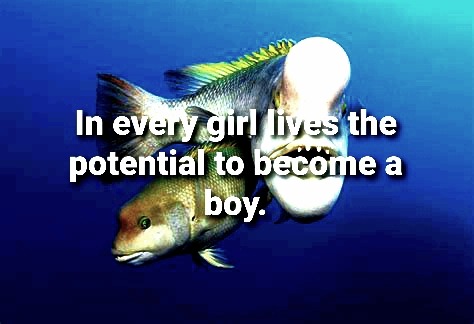
asian sheepshead wrasse got featured in documentary and I have been inspired
4K notes
·
View notes
Note
Gold spot wrasse?

fish 342 - gold spot wrasse/gold spot pigfish
help out palestine
214 notes
·
View notes
Text

first fish for naturality :: the rose-veiled wrasse !!! it spawns in the deepest depths & is extraordinarily rare . due to this , they can reproduce without being bred .
they are also known as the " gem of the sea " in-game , & stumbling across them yields an achievement of the same name

a mockup of what they might look like in the in-game oceans ^^
#▣ ] ┅ Naturality#minecraft#art#mineblr#minecraft mods#blockbench#this is a post about#species :: Cirrhilabrus finifenmaa#wrasse#fish#fish art#fishblr#rose-veiled wrasse#Naturality: A Very Fishy Update
182 notes
·
View notes
Text






My biggest Splatoon OC thing yet; it's a full weird-sea-people-band!
MOUTHWASH FOR WHALES (クジラ用のうがい薬)
* Post-punk / Krautrock band.
* Best known for their singles "Polyp Anna", "Inkopolis I Love You But You're Sinking Me" and "Crispy Scales".
* Their music is far too weird to get any Turf War play.
* Consists of vocalist Ella, drummer Manuel, guitarist O'Carroll, keyboardist Tharassa and sound engineer Stahli.
ELLA (エラ)
* Salmonid (oversized Smallfry).
* Her birth name is The Lustful Bleeding Axe of Ikejime Rock (生首岩の好色な出血斧).
* Screams more than sings.
* Stopped participating in Big Runs after eating a terrified Inkling boy in his home.
* Is considered a sellout in Salmonid society for refusing to fight and die.
* That's hair dye dripping down her face.
* Vegan hippie, has a bedroom full of rose quartz.
MANUEL (マヌエル)
* Portuguese man-o'-war.
* Fascinated with the history of telegraphy.
* A bit of an airhead.
* Talks to his zooids for advice.
O'CARROLL (オキャロル)
* Octocoral.
* Tired of people assuming he has something do with the Octarians.
* Stylises himself as a badass, but really rather spineless.
* Loves younger men.
* People have often mistaken him for a Christmas tree.
THARASSA (ヴェラ)
* Moon wrasse.
* Thinks of themselves as "punk", but actually comes from a wealthy family of caviar farmers.
* Smokes a lot.
* Wishes people would stop calling them a girl.
* Afraid of the ocean.
STAHLI (スタリ)
* Mutant algal bloom.
* Came into existence quite recently.
* Born from algae exposed to radioactive Salmonid poop.
* A theologer in his spare time.
* Gets claustrophobic very easily.
I've even made an album cover.
This took me hours, but it was totally worth it. Worse ways to spend my life, I suppose.
The whole band is CC-BY-SA 4.0, feel free to use them anywhere you like!
#creative commons#digital art#painting#marker#splatoon#splatoon oc#splatbands#salmonid#man o war#octocoral#coral#wrasse#moon wrasse#fish#algae#algal bloom#album cover
164 notes
·
View notes
Text

Cleaner-wrasses and goatfish By: Douglas Faulkner From: The Fascinating Secrets of Oceans & Islands 1972
#cleaner wrasse#wrasse#labriform#bony fish#fish#goatfish#perciform#1972#1970s#Douglas Faulkner#The Fascinating Secrets of Oceans & Islands
147 notes
·
View notes
Note
can i have an underrated fish with interesting sexual dimorphism :3
Hands down, has to be my bestie Bird Wrasse

You get a Bird Wrasse (female)
Ameiurus nebulosus
And for a special treat here’s the male

131 notes
·
View notes
Text
Daily fish fact #695
Amanda’s flasher wrasse!

This species was only very recently named and discovered. It used to be considered a part of the red-tailed flasher wrasse species, but genetic studies and morphological differences prove that this Australian fish is its own distinct species!
#i forgot to prepare a fish fact today. sometimes a girl has got to take it easy#making some use out of my “secondary” fish research#fish#fishfact#fish facts#fishblr#marine biology#marine life#marine animals#sea creatures#sea animals#sea life#biology#zoology#wrasse#flasher wrasse#amanda’s flasher wrasse
197 notes
·
View notes
Note
hi i saw a post about the fish playing with the human child and even though your addition to that post is 3 years old by now i would love to hear more about ftm sheephead fish :3 (no pressure btw!)
Fish curiosity, in my inbox?? It's more likely than I think, apparently! xD
First off, there's actually multiple fish dubbed 'sheephead'! There's the sheepshead- note the extra S in there- and they look like this:


And yes those are their teeth. Horrifying tbh, but they're very good at what they do- crushing invertebrates and other shelled snacks! They're an Atlantic species that sticks to temperate and warmer waters, and they max out at about half a meter in length.
That's not the fish we're talking about today. The focus of today is the California sheephead wrasse- note the lack of a second S- also known as the 'sheephead' for short. Not confusing at all! We definitely don't bash our heads into walls over the naming conventions and lack of record-keeping of our scientist predecessors.
THIS is the sheephead wrasse, the species of the lovely and now Tumblr-famous Red! :D With a length of up to a FULL meter, they're a whole different size class of fish! They can be found along the west coast USA from the Baja Peninsula all the way up to Monterey, and dwell almost exclusively in kelp forests and nearby environments. I will use one of Red's pics as an example of female coloration-

The lighting isn't great but you can see how her body is streamlined, and besides the white underside of the jaw, has a salmon-pink coloration! Females can be pink or a dull silver-beige. And much like other large marine wrasse, MALES have a drastically different appearance.
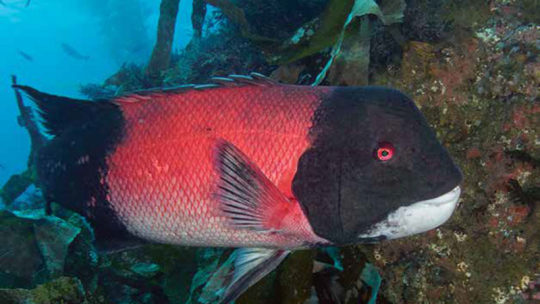

This thing is built like a damn tank!! Sheephead are a species of wrasse that shift colors to gain those striking black scales and physically bulk up when becoming males- because guess what? ALL OF THEM ARE BORN FEMALE! By default, all male California Sheephead are FTM trans :) They use that bulky head and extremely tough set of jaws to not only hunt their preferred prey- mollusks, gastropods, and bivalves, etc- but also to bash and chomp down on rival males. This one has won many battles, look at that scarred up muzzle!
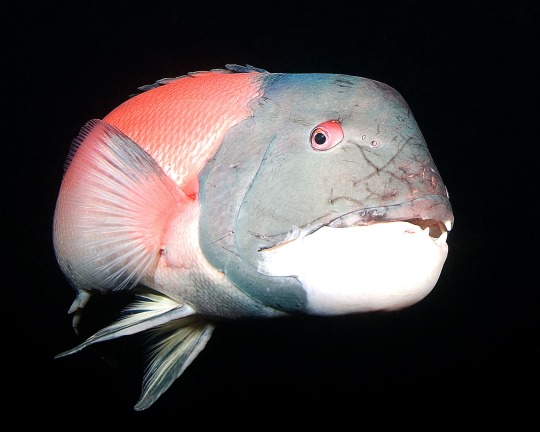
The sex change is determined by several factors, as it's not guaranteed all sheephead will eventually become males. Because sheephead school in a harem system- many females to very few males- in order to maximize pressure of stronger offspring, the biggest and healthiest sheephead male will drive out competition from the school. Naturally, a sheephead that lives longer and gains a greater size will have a much higher chance of shifting from a female to a male, if the conditions are right. Stress induced from competition can suppress the hormones that stimulate this transition in females, so they're less likely to gain size and shift from female to male if there's already strong competition taking place. However, in the event there are too few males to mate with the females, or no males present at all, the biggest female will start transitioning to fill the empty slot! It's a long process that can take as few as a couple months, or up to years, depending on resources available.
Conversely, if there are TOO MANY males, they can revert back into females! This process also takes a long time, and is a lot more rare to witness, especially because right now male California sheephead in particular are being spear-fished into becoming an Endangered species :c Sheephead adult males in good condition are considered a trophy animal in spear-fishing and similar marine trophy hunting off the West coast, and because males in particular are being targeted, the gene pool is being reduced when it wrecks the harem structure of schools.
As a fun fact- they're also an incredibly smart fish, and can form relationships with humans, as demonstrated with me and sweetiepie Red cx There's many documented cases of large marine wrasses forming long-term friendships with divers! Here's a humphead wrasse that made friends with a diver she learned would crack snails open for her with a hammer:
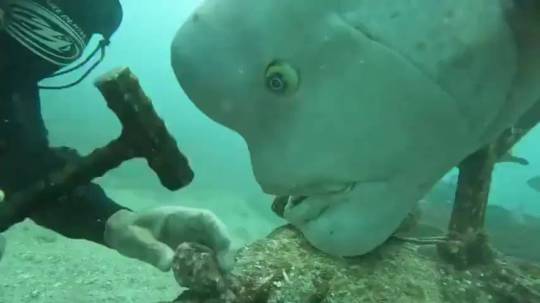
I don't work at the facility with Red anymore, but I currently work with two unnamed adult male sheephead, and once again they both like me and seem to despise all my coworkers, even if I never had the opportunity to train them like I did with little Red xD They pick favorites I guess? Now if only I could make friends with the garibaldi...
577 notes
·
View notes
Text
Wet Beast Wednesday: California Sheephead Wrasse
A lot of people through history and the modern day have an overly simplistic view about sex, both in the sense of biological sex (that is, what gametes something produces) and sex as in the act of mating. A lot of people think that sex is just a strict binary between males and females, but nature is far more diverse and varied than that (even in humans. Intersex people do exist after all). Today I'm showcasing one of the animals that completely goes against the alleged sex binary: the California Sheephead Wrasse. And yes, this is a pride post.

(Image: a male California Sheephead Wrasse in a tank in the Monterey Bay Aquarium. It is a large fish with a bulbous head. The head and tail are black, midsection is pink, and the belly and chin are white. End ID)
The California Sheephead (Semicossyphus pulcher) is a large fish in the Wrasse family of Labridae. They are sexually dimorphic, with the males and females appearing distinct from each other in size, shape, and color. Males are larger than females, reaching up to 91 cm (3 ft) and 16 kg (35 lbs), though there is quite a bit of size variation based on food availability. They have flatter faces than females thanks to a bulbous bump on the forehead. This lump is the namesake of the fish, since it allegedly make it look like it has a sheep's head. I personally don't see it at all. Males have black heads and tails with a white chin and underbelly and pink midsection Females are smaller and colored silvery to a dull pink all over except for their white chins and underbellies. There isn't really a maximum size or weight for females for reasons I'll get into later. The fish have large canine teeth that protrude from the mouth and modified throat bones that form a grinding apparatus called the throat plate.
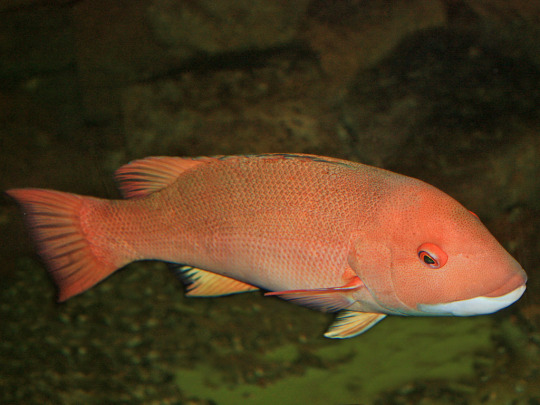
(Image: a female California Sheephead. It has a less bulbous head than the male and is a pale pink all over, except for the white belly and chin. End ID)
Sheepheads, like many wrasses, are sequential hermaphrodites. A sequential hermaphrodite can transition between sexes during its life (as opposed to a simultaneous hermaphrodite, who can produce both sperm and eggs at the same time). Every California Sheephead is born female and some will become male later in life, making them protogynous. Protogyny is the most common form of hermaphroditism in fish, with over 75% of known sequentially hermaphroditic fish species being protogynous. This transition is a one-way process, males will not turn back into females. The transition is triggered by a number of factors, primarily size and the local availability of males. If there are not enough males in the area, the largest female will transition to male to fill the role. This transition takes between 2 weeks and a few months depending on availability of food and other conditions (temperature seems to play a role) and the fish will be capable of producing sperm before fully assuming the male morphology.
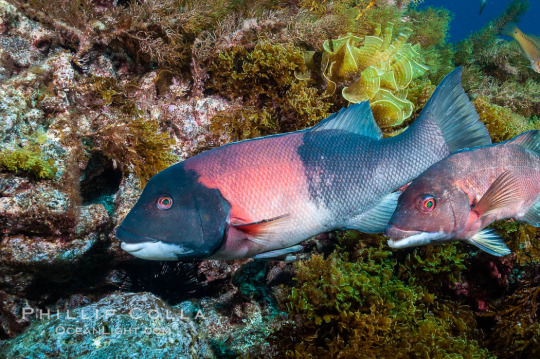
(Image a male and female Sheephead swimming next to each other. The female is roughly half the size of the male. End ID)
During mating season (July-September), males will pick a territory and claim all nearby females as mates. A younger male without a territory may challenge an alpha male to try to claim his territory. These fights are often resolved with threat posturing, but if neither male backs down, they will fight with biting and raking teeth against the opponent. During mating season, females will release batches of 375,000 eggs almost daily for males to fertilize. During this time, the alpha male will patrol his territory to mate as much as possible while chasing off smaller males who may attempt to sneakily fertilize some of his female's eggs. The larvae are planktonic for their first 34-78 days, and will sink as they grow. Juveniles have a different coloration to the adults. They are orange, with a white stripe running down the body and dark spots on the fins. The average maximum age of a California Sheephead is 21 years, but the oldest individual on record was 53 at the time of capture.
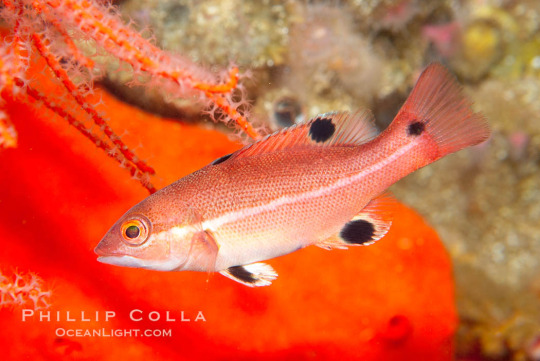
(Image: a juvenile Sheephead. It is a small, orange fish with a white stripe running from eye to tail and black spots on the pelvic, anal, dorsal, and tail fins. End ID)
The California Sheephead lives on rocky reefs and kelp forests from southern California to the Baja peninsula and Gulf of California. They prefer shallow water between 3 and 30 meters (10 - 100 ft) deep, though males will occasionally venture deeper. Sheepheads are predators that hunt hard-bodies invertebrates including urchins, shelled molluscs, and crabs. Juveniles hunt smaller prey such as sponges, bryozoans, and barnacles. The protruding canines give the fish a better grip when trying to pry food off of rocks. They crush the hard shells of the prey with sharp teeth before swallowing. The shells are then further ground down by the throat plates. Smaller individuals have been known to break open urchins too large to bit by picking them up and hammering them into rocks. Sheepheads play an important role in kelp forest ecosystems by keeping urchin populations down. Urchins eat kelp and without predators keeping their numbers in check, can reduce kelp forests to urchin barrens. Sheepheads are known to have a high site fidelity, meaning they will return to the same places over and over. They will maintains a sleeping spot (usually a crevice they can hide in or rock they can hide under) and return to the same places to hunt. They are diurnal and return to their sleeping spots at night to avoid predators.

(Image: a male Sheephead trying to pick up a sea urchin with tis mouth. End ID)
California Sheephead Wrasses are classified as vulnerable to extinction by the IUCN. Their primary threat is overfishing. The Sheepheads have been commercially fished since the 1800s and their numbers have dropped. The hermaphroditic nature of the species actually makes things worse. Commercial fishers are incentivized to catch the largest fish and the largest Sheepheads are the males and females that are likely to transition to male. Unlike with other species, there aren't small males around to make up for the loss of large males to fishing since the small fish are the females. The loss of males and the largest females (who are the ones most likely to transition to male) means there aren't enough males around during mating season to keep the population high enough. The introduction of marine protected areas and fishing regulations have helped the population recover. The loss of the Sheepheads is a big deal since they're one of the species doing the most to keep the kelp forests healthy by eating urchins. Natural predators of the Sheepheads include sharks, sea lions, and giant sea bass.

(Image: a fisherman holding a male Sheephead on a boat. The large canines of the fish are particularly visible. End ID)
#wet beast wednesday#transmasc icons#california sheephead wrasse#sheephead wrasse#wrasse#fish#fishblr#fishposting#pride#hermaphrodite#sequential hermaphroditism#protogyny#marine biology#biology#zoology#ecology#animal facts#educational#informative#image described
101 notes
·
View notes
Text


Klunzinger's or Rueppell's Wrasse (Thalassoma rueppellii), family Labridae, order Labriformes, endemic to the Red Sea
Like most wrasses, all of the younger individuals are females, that become male later in life (protogynous hermaphrodite).
photographs: IKER & Dr. Thomas Dörner
#wrasse#fish#bony#thalassoma#labridae#labriformes#ocean#ichthyology#animals#nature#middle east#africa
474 notes
·
View notes
Text
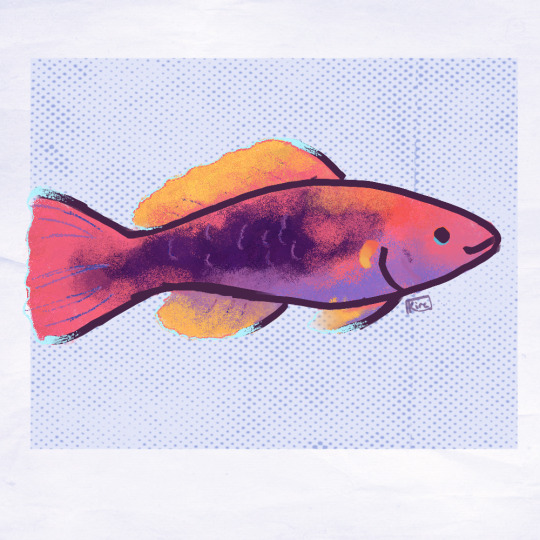
Lubbock's wrasse for day 3 yipppeeeeee
@fish-daily
196 notes
·
View notes
Text
Fish of the Day
Today's fish of the day is the California sheephead!

The California sheephead, as some of you who have been here since the early days will know, happens to be the first ever fish I wrote about for fish of the day back in January 2022! Known by the scientific name Bodianus pulcher, (formerly Semicossyphus), this fish is a species of wrasse in the Pacific. Found along the coast of California and Mexico, stretching from Monterey Bay California to the Gulf of California. They live along the kelp forests common in this area. Although, there are populations living along rocky reefs and sandy seabed areas. The fish are highly territorial over their home, and only settle in a very small refuge area, which they protect. These areas and the cycle of migration with the California sheephead are shaped almost entirely by light levels, as they travel between a refuge area and a foraging area throughout the day, and then when spawning these fish travel to a breeding area. This is why some issues have arisen due to overspilling light pollution by humans.

Their diet consists primarily of sea urchins, although they also prey on crustaceans, mollusks, and other fish. Their role in the ecosystem of kelp forests can not be understated, which is why the overfishing of them by humans is such a problem. This is because the overabundance of urchin in an area can decimate entire kelp forests at a rate of 30 feet a month in herds. Their diet of urchins allows these fish to get as large as 3 ft in length. Despite their large size, these fish are regularly predated on, primarily by sharks in the area. The California sheephead can warn other fish in the area of their plight however, damage released chemical cues come forth once the skin is ruptured, informing other fish in the area. These chemical cues are not always perfect however, as fish infested with parasites reduces reliability of these cues.

California sheephead, as like many wrasse, are born female and can morph into functional males throughout their lifespan, called Protogynous sex change. This change is moderated by a steroid hormone, and is undertaken by the largest and best fed individuals in an area. Sheephead are hermic spawners, and males have a group of females of which they protect and breed with. When the male for a group of females passes away, the largest female will morph into a male form and take the role. This can take anywhere between 2 weeks or several months. The mating season for these fish is between June and September, and the male will lead all his females in a circular pattern, releasing eggs and sperm. Females during this time can release as many as 130,000 to 375,000 eggs in a day, which will hatch into planktonic larvae. They will continue life as larvae for 34 to 78 days, before settling in a shallow reef and growing as normal. By the time they reach an age of 4 and a size of 10 inches, the fish are ready to spawn, although this is variable between populations. These fish can live upwards for 20 years in the wild, and as long as 50 in captivity, living through tens of breeding seasons, and producing hundreds of children.

That's the California sheephead everyone! Have a wonderful day

#California sheephead#sheephead#wrasse#California#fish#fish of the day#fishblr#fishposting#aquatic biology#marine biology#freshwater#freshwater fish#animal facts#animal#animals#fishes#informative#education#aquatic#aquatic life#nature#river#ocean
37 notes
·
View notes
